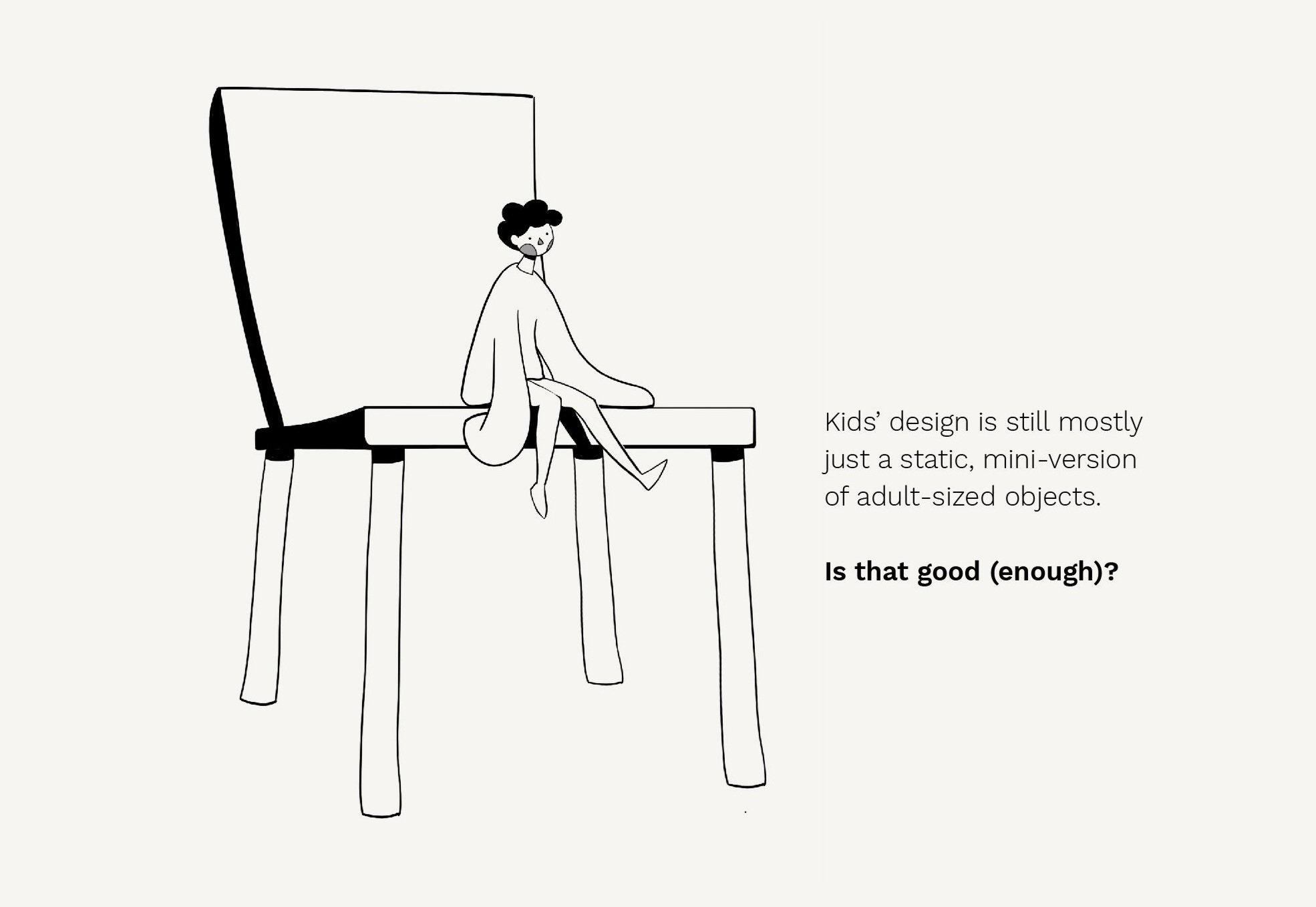Why do we think most children's play and study spaces are disastrous?
5 minutes read | Rethinking kids’ design series, Pt. 1 | Written by Dorja Benussi
I think of design as an agent of change that re-examines the status quo and defines a new, better future. Especially when it comes to our children. Kids’ design is still mostly just a static, mini-version of adult-sized objects. Is that good (enough)? Why even question it?
Well, this is the thing. Movement really is food for the child’s brain. All our thoughts and behaviours are affected by our autonomic nervous system, which is directly affected by our physical environment. Through our interaction with the surroundings, our body goes through a whole range of processes called sensory integration. In adults, we mostly think about our mood and level of focus. For kids, sensory experiences are an integral part of their learning process and their emotional well-being. While surroundings are important for adults, for children they are critical.
Sensory integration directly influences their growth, development and overall learning. It is also the first step towards establishing healthy emotional regulation - the key for their future mental health and wellbeing. I believe that, as parents and designers, we have a responsibility to shape a more thoughtful, inclusive and supportive environment for our kids. It’s actually pretty simple once we learn what these little humans need to thrive.
Photo by Annie Spratt
Should kids’ environments be different from the ones for adults (an absolute yes!) and why?
Research shows that the vast majority of our behavioural and emotional responses are learned in the first 7-10 years. What does this actually mean and how is it connected to the physical environment and design?
Basic brain architecture begins to build before birth and it continues into adulthood. Early experiences affect the quality of that architecture by establishing either a solid or fragile foundation for learning, health and behaviour that follows. In the first few years of life, more than a million new neural connections are created every second, which slows down as we move through life. The brain is the most flexible, or “most plastic”, early in life in order to adapt to a wide range of new experiences and interactions. As it matures, the brain becomes increasingly specialized for more complex functions, and thus, less able to reorganize and adapt to new learning. Early plasticity means that it is easier and more effective to influence a child’s brain architecture than to reshape parts of the brain in adulthood.
Strong sensory intelligence allows children to be mindful so they can balance themselves and feel grounded and content. This is the basis for all further learning.
It's all about potential. It is important to emphasize how much the environment affects all people, regardless of age. For adults, we mostly talk about mood and productivity when we think about interactions with the design environment. When we think about children, we focus on brain development. It seems pretty clear how big a difference this is.
When I say potential, I mean the ability that a child has to interact with its environment. Physical experiences nourish the brain. Strong sensory intelligence forms building blocks for development, mental health and overall learning. It allows children to be mindful so they can balance themselves and feel grounded and content. This is the basis for all further learning.
So after looking at the science showing how important that interaction is, this question always arises - are we using that potential at all? In design, in parenting, in any given situation. I’m aware how “using neuroscience in design and parenting” sounds like; but actually, applying it is not at all complex. The answer lies in the notion of sensory integration. Yes, yes, my ultra favourite word sensory. It’s like some secret key for both parents and designers, that’s how I see it. This by itself is a rather complex area, if viewed from the perspective of the medical profession. But if we extract the relevant parts of the theory - we get literal, direct, and fairly simple tips & tricks.
During the first years of the child’s life, sensory integration is the most important stepping stone for all further development. If nurtured, it becomes a basis for their emotional regulation and mental capacity in adulthood. Everything that our kids think, feel and how they act is a product of their central nervous system, which is directly affected by their surroundings. To be able to reach their full potential, they first need to start learning how to regulate their own emotions. In order for that to even be possible, (as you may assume), they need to build their sensory intelligence first. And this has everything to do with the physical space surrounding them. Interior design, outdoor parks, furniture, toys, everything.
This is why I’m passionate about sharing everything I learn on the intersection of design and parenting. I’m aware that these first blog posts will definitely reveal my indestructible contemplative nature, but (!) I am determined to keep turning it all into easy-to-follow parent-brain-friendly short little instruction-like writings. But let’s finish on a more serious note.
Mindfulness is a skill that can be nurtured from early on, but it requires practice. We are the ones who can provide the tools. Let’s start doing it (more).
Written by
Co-founder of Tink Things and Benussi&theFish
Designer & creative director, mom, dancer, overthinker, peace pursuer






